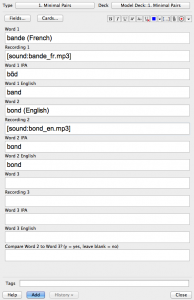Phase 1: Sounds – Ear Training: Minimal Pair Flashcards
These flashcards are designed to train your ears to hear new sounds. Basically, if you want to learn how to hear the difference between notre and nôtre in French, then you can use these cards to do it. They’re based on the research described in this video and this article – the same research upon which I based my pronunciation trainers. If you’re using those trainers, you won’t have much need of these cards. But should you be studying a language I’m not yet covering, or if you just like to do things on your own, use these card models to train your ears.
Before you start, you’ll need the following:
- Some tricky word pairs. Often, your textbook will include these in the beginning, or sprinkled throughout the book in little “Pronunciation” sub-sections. You’re looking for pairs of words that differ by only one (tricky) sound, like notre/nôtre, huis/oui, and choeur/court.
- Recordings of those word pairs. I like to use Rhinospike.com and Forvo.com. It’s not necessary to have the same person pronounce both words, but I find that it simplifies things in the beginning and helps you focus your attention on the subtleties in the sounds. If you have a big list of these word pairs and you find someone on Rhinospike to record all of them, you’ll need to chop the long audio file into small chunks. Use a sound editing program like Audacity for that.
- (Optional) English translations and International Phonetic Alphabet (IPA) transcriptions of those words. I like to have these handy, just to make my flashcards a little more entertaining and a little prettier. You can get (crappy) English translations from Google Translate, and sometimes, you can get IPA transcriptions from Wiktionary.
What the flashcards look like:


How to make them
- Click the “Add” button on the top of your Anki window
- Click the button on the top left, next to where it says “Type.”
Select “1. Minimal Pairs” from the list
And click “Choose” on the bottom right.Change this… - Click the button on the top right, next to “Deck.”
Select “[Your deck name]::1.Minimal Pairs” from the list and press “Choose”
(Note to advanced Anki users: I added this step because I have some special deck settings for these types of flashcards that are stored in this sub-deck. It makes it so that you need to get these flashcards right 4 times in a row the first time you see them, so that you get enough exposure the first time through)
- Now you can start making flashcards. To make the bande/bond flashcards above, here’s how I filled out my flashcard info (click to magnify):
Notice that all the items in Word 3 are empty. They’re only there if you’d like to compare three similar sounding words (say, bande, bond, and bonde). Then you fill out Word 3, put a “y” in that last box, and you’ll get three different comparisons, all at once (bande-bond, bande-bonde and bond-bonde).
- Click the “Add” button on the bottom to make your flashcards.








